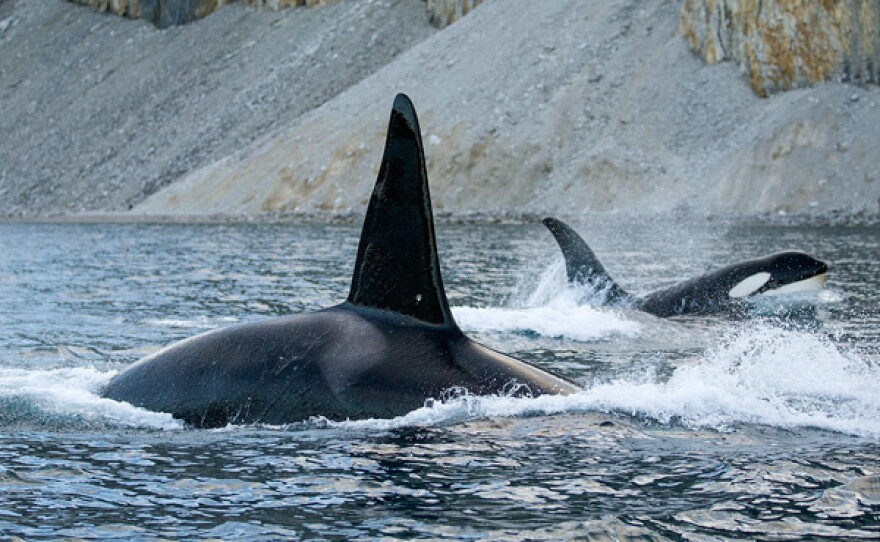This program is part of our TV Membership Campaign. Support quality programming you depend on from KPBS. Give now!
Experience the splendors and compelling stories of the natural world from all over the globe. NATURE delivers the best in original natural history films to audiences nationwide.







"Invasion Of The Killer Whales" - A shift of power is taking place at the top of the world. The Arctic is undergoing a dramatic change, and with this change one iconic Arctic hunter may soon have to give way to another as solid ice turns to open sea. The polar bear, once king of the North, needs ice to stalk its prey. Killer whales, or orca, on the other hand, are unable to hunt in an ocean locked in ice. As the ice increasingly disappears, the tables have turned.
Polar bears are struggling to survive while the now open ocean provides bountiful new hunting grounds for the whales. There appears to be no stopping these voracious predators, whose fearsome presence has been formerly unknown so far north in Canadian waters. Hunters and hunted in this once frozen world must now make way for the arrival of the most successful ocean predator of them all.
"Invasion Of The Killer Whales" presents information gathered by research scientists and a film crew documenting the movements and behavior of the Arctic killer whales and their impact on predator and prey. Augmenting their work are reports and reflections provided by Inuit hunters, who have long had first-hand experience with polar bears and the prey animals polar bears once survived on – seals, narwhal, belugas and bowhead whales – which are longtime food sources for the Inuit, as well. The program airs Wednesday, November 19, 2014 on PBS.
The documentary includes interviews with several Inuit who have seen and even filmed killer whales attacking narwhal. Inuit hunters were the first to witness the arrival of killer whales in the rich Arctic hunting grounds and some feel the herding strategy the whales use to attack the narwhal have in fact made their job easier. But scientists caution that with killer whales going after the same food sources as the Inuit, their way of life could undergo a change in the future.
"Invasion Of The Killer Whales" follows an August 2013 expedition to satellite tag and track killer whales launched by Steve Ferguson, a marine biologist at Fisheries and Oceans, Canada, whose 2012 study first reported the killer whales’ arrival so far north. A group of 20 tagged killer whales traveling at fairly rapid speed is followed as they head straight toward the summer nursery grounds of a pod of narwhal and their young.
The science team and film crew are stunned as they arrive to see the killer whales lunging at the beach, pinning the entire pod of narwhal in shallow water before devouring them all. The orca are organized and ruthless, and stop at nothing. Even bowhead whales, twice the length of killer whales, are a target, especially mothers and their young. Their only recourse is to hide in the sea ice close to the shoreline, where the orca cannot follow.
Polar bears may be classified as marine mammals, like killer whales, but they are not adapted to hunting in the water despite being able to swim huge distances. They need the ice to hunt and as it vanishes they can no longer reach their traditional prey. With each Arctic summer providing more water and less ice, some polar bears are forced to try their luck with seaweed, birds, and Arctic char, a type of salmon, as they migrate upstream to spawn. Their ability to find food and develop new hunting skills may prove crucial to their survival in a changing Arctic.
NATURE is a production of THIRTEEN Productions LLC for WNET. For NATURE, Fred Kaufman is executive producer. "Invasion of the Killer Whales" is a production of Terra Mater Factual Studios and Brian Leith Productions in co-production with NDR Naturfilm/Doclights and THIRTEEN Productions LLC for WNET.
NATURE is on Facebook, Tumblr and you can follow @PBSNature on Twitter. Past episodes of NATURE are available for online viewing.
Killer Whales Attack Pod of Narwhal
"A group of 20 tagged killer whales traveling at fairly rapid speed is followed as they head straight toward the summer nursery grounds of a pod of narwhal and their young. The science team and film crew are stunned as they arrive to see the killer whales lunging at the beach
Polar Bears Try to Catch Salmon
"Polar bears need the ice to hunt and as it vanishes they can no longer reach their traditional prey. With each Arctic summer providing more water and less ice





